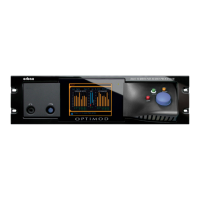OPTIMOD SURROUND PROCESSOR OPERATION
3-7
the dynamic range of dialog must not exceed 15dB if it is to be intelligible to 99% of
viewers under common domestic viewing conditions. Moreover, research has re-
vealed a “comfort zone” (within which viewers will not adjust the volume controls
of their receivers) that is even smaller: +2 to –5 dB as measured on a subjective
Loudness Level meter like the 8685’s CBS Loudness Level meter or ITU BS.1770. Fea-
ture-film dynamic range is inappropriate for home viewing (except in dedicated
home theaters) and the dynamic range of a significant portion of video source ma-
terial must be compressed to best serve the audience. The challenge (which Optimod
8685 effectively meets) is to control dynamic range unobtrusively.
OPTIMOD 8685 can be adjusted so that the output sounds as close as possible to the
input at all times (using the Two-Band Protection Limiter preset), or so that it sounds
open but more uniform in frequency balance than the input (using the Two-Band
structure or running the Five-Band Structure with slow release time), or so that it
sounds dense, quite squashed, and very loud (using the Five-Band Structure with
faster release times).
In television audio, inconsistent loudness between channels or program elements is
annoying, so the dense, loud setup is never appropriate. The 8685 offers two-band
and five-band presets (whose names begin with “TV”) that exploit the AGC’s and
multiband compressor’s compression ratio controls to subtly control dynamic range
in sound for picture applications. These presets effectively and unobtrusively main-
tain dialog intelligibility while retaining a sense of dynamic range, allowing low-
level elements to be heard easily. Meanwhile, the CBS Loudness Controller prevents
subjective loudness from exceeding a preset ceiling.
The “TVxxxx” presets are designed for digital television transmission
(which uses no preemphasis) and the “TVAxxxx” presets are designed for
analog television transmission that uses 50μs or 75μs preemphasis.
The preset tuning controls on the 8685 give you the flexibility to adapt the process-
ing to individual program segments. In most cases, your goal should be to choose
the type of processing that best optimizes dynamic range while controlling the
loudness of the loudest sounds so that they are not irritating and are consistent with
the loudness of other stations or sources. When the 8685 is otherwise set up cor-
rectly (so that it is cognizant of the D
IALNORM metadata you are transmitting to
viewers), its TVxxxx presets achieve this goal most precisely by exploiting the loud-
ness controller. The “radio-style” presets are crafted to match the target loudness as
well as can be achieved without use of the loudness controller.
If you want more consistent loudness from a “radio-style” preset, set its
L
OUDNESS CONTROLLER THRESH control to –10 dB, turn up its MB LIMITER
DRIVE control until the loudness controller gain reduction meter indicates
about 3 dB of gain reduction with typical program material, and save the
result as a user preset.
Optimod 8685 in Audio-Only Applications: From Bach to Rock
The 8685 can be adjusted so that the output sounds:

